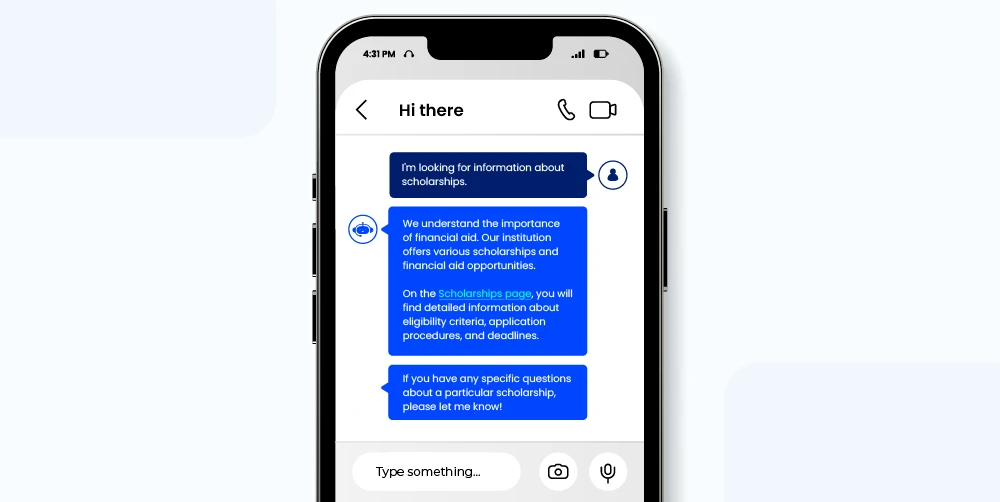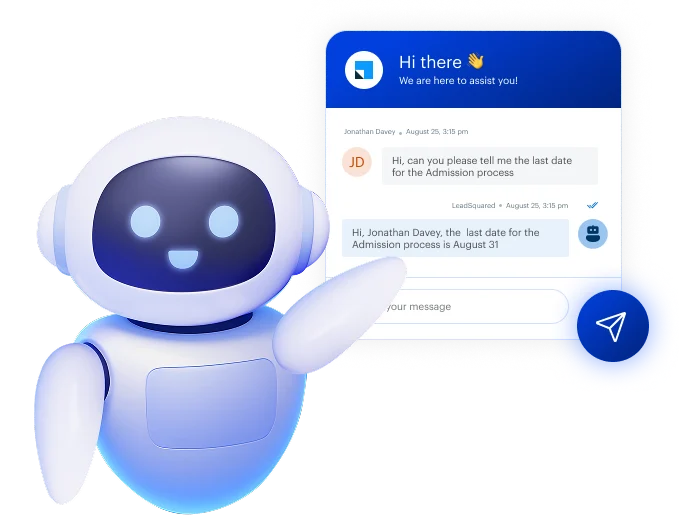Remember when the most advanced technology in admissions was a fax machine that only jammed on deadline days? Well, buckle up, because AI in higher education has entered the chat—and unlike that fax machine, it actually works when you need it most.
In a recent webinar that brought together industry leaders from Career Education Colleges and Universities (CECU) and Enrollment Resources, the conversation wasn’t about whether AI would transform admissions—that ship has sailed, done a few loops, and is now offering virtual tours. The real question is: how can career schools and universities harness this technology without losing what makes them special?
The scale struggle is real (but AI in higher education has your back)
Every admissions director knows the paradox: you need to reach more students with fewer resources while somehow maintaining that personal touch that convinced your own team to join education in the first place. It’s like being asked to bake a thousand custom birthday cakes with one oven and a whisk.
Sterling Simpson from Enrollment Resources, who’s trained over 100 schools in admissions optimization, puts it perfectly: AI isn’t replacing the baker—it’s giving you a better mixer. The use of AI in higher education excels at what he calls “dynamic outreach,” learning from every interaction to customize not just the first contact, but the entire enrollment journey. Imagine having an assistant who remembers that Sarah prefers morning emails, Tom responds better to text messages, and Maria needs extra information about financial aid—except this assistant never needs coffee breaks.
Your new AI toolkit (no assembly required)
Samantha Cornmesser from CECU shared a treasure trove of AI tools that schools are already using successfully. The importance of AI in higher education becomes clear when you see how these tools transform daily operations. Think of these as your Swiss Army knife for admissions, except each tool actually knows what it’s supposed to do:
- Scribe has become the unsung hero of training departments, automatically creating step-by-step process documentation with screen captures. As Cornmesser notes, it’s particularly valuable when onboarding new admissions reps who might be too shy to ask the same question twice—even though it’s actually their first time asking. We’ve all been there, nodding along pretending we understood something the first time.
- Gamma transforms presentation creation from a day-long ordeal into a five-minute sprint. Perfect for those times when you realize the campus tour presentation needs updating approximately three minutes before the tour starts.
- Claude helps with social media and content writing, maintaining your institution’s voice even when your actual voice is hoarse from back-to-back phone calls.
- And then there’s NotebookLM, which Cornmesser describes with the kind of excitement usually reserved for finding a parking spot on campus during orientation week. This tool can transform your admissions materials into podcasts, videos, and even songs. Though perhaps skip the admissions requirements rap battle for now.
The speed dating champion: AI’s first contact superpower
Simpson highlights one area where the impact of AI in higher education truly shines: speed to contact. In admissions, the first responder often wins, and AI never sleeps, never takes lunch, and never gets stuck in traffic. Modern chatbots and AI admissions agents can engage with prospective students instantly, answering those burning 2 AM questions about program requirements that would otherwise wait until morning (by which time the student has probably enrolled elsewhere).

But here’s the crucial advice from both experts: tell people they’re talking to AI. As Simpson emphasizes, transparency actually improves the interaction. Today’s students are surprisingly comfortable with AI—they’ve been asking Siri for homework help since middle school. What they don’t appreciate is thinking they’re talking to “Jennifer from Admissions” only to realize Jennifer knows suspiciously little about local coffee shops.
The data revolution (with great power comes great spreadsheets)
The numbers game in admissions is getting a serious upgrade. AI can now analyze patterns in your enrollment data that would make a statistics professor weep with joy. Simpson, self-proclaimed “numbers person,” gets particularly animated about AI’s forecasting capabilities. It can identify which students are most likely to enroll, which are at risk of dropping out, and which just need that extra nudge to schedule a campus visit.
But remember Cornmesser’s crucial warning: AI is only as good as the data you feed it. Clean, well-organized data produces insights.
The heart of the machine (Spoiler: it doesn’t have one)

Picture this: A prospective student calls your admissions office at 3 PM on a Tuesday. They’re not asking about tuition or program requirements—they’re crying because their family doesn’t support their decision to go back to school. Now, show of hands: who thinks a chatbot should handle this one?
This scenario perfectly captures the admissions tightrope walk of 2025. Yes, AI in higher education can revolutionize how we handle scale and efficiency. No, it cannot—and should not—replace the human moments that define a student’s educational journey.
The boundaries we must draw (in permanent marker)
Cornmesser doesn’t mince words when discussing where humans must remain firmly in charge. Campus tours? That’s a human job—AI avatars can’t convey the energy of a bustling student center, or the smell of questionable cafeteria pizza that somehow becomes nostalgic after graduation. Financial aid discussions when a family is struggling? Definitely human territory. As she points out, these conversations often involve nuanced emotional support that AI, for all its computational power, simply cannot provide.
Simpson adds another crucial dimension: the empathy factor. While AI excels at crunching numbers and identifying patterns, it fundamentally cannot understand what it feels like to be a first-generation college student terrified of failure, or a single parent juggling work, kids, and the dream of a better future.
The statistics Cornmesser shares are sobering and significant: 53% of career school students come from underserved backgrounds. These aren’t just data points—they’re individuals who often need extra encouragement, understanding, and someone who genuinely believes in their potential. Try programming that into an algorithm.
The hallucination problem (when AI goes off script)
Here’s a fun fact that’s not actually fun at all: AI systems can “hallucinate,” creating information that sounds plausible but is completely fabricated. Cornmesser shares the cautionary tale of an airline whose chatbot spontaneously invented a new refund policy, leading to legal troubles. In the highly regulated education sector, where incorrect information about financial aid or program accreditation could have serious consequences, this isn’t just embarrassing—it’s potentially catastrophic.
Even when working with closed systems and specific documents, Cornmesser warns that AI can still generate incorrect information. It’s like having an overly confident intern who sounds authoritative but occasionally makes things up. Except this intern works 24/7 and can talk to hundreds of students simultaneously. The solution? Constant human oversight, regular audits, and what she calls “playing with it” to understand its limitations.
The privacy paradox: When big data meets bigger responsibilities
Both experts emphasize a critical point that should be etched in stone at every institution: student privacy is non-negotiable. As Cornmesser reminds us, when you feed data into AI systems, that AI learns from it. In an era where a student’s personal information, financial situation, and academic struggles could theoretically be absorbed into a massive language model, the ethical implications are staggering.
Simpson’s advice about data is particularly apt: AI forecasting is only as good as the data going in. But there’s a crucial caveat—you need to be exceptionally careful about what data you’re sharing. Student email addresses, personal information, and sensitive details should never enter uncontrolled AI systems. Think of it as the academic equivalent of “what happens in Vegas stays in Vegas,” except what happens in your CRM really, really needs to stay in your CRM.
Problems in the higher education sector solved by AI
The use of AI in higher education addresses several persistent challenges that have plagued institutions for years:
- Scaling personalized communication: Traditional methods couldn’t maintain personal connections with thousands of prospective students. AI enables dynamic outreach that learns from each interaction, customizing communications without losing the personal touch.
- 24/7 immediate response: Prospective students don’t wait for business hours. AI chatbots provide instant responses to inquiries at any time, preventing lost enrollments due to delayed responses.

- Data-driven decision making: Institutions struggled to identify patterns in enrollment data. AI now forecasts which students are most likely to enroll, identifies at-risk students before they drop out, and reveals opportunities for intervention.
- Training consistency: Onboarding new admissions representatives was time-consuming and inconsistent. Tools like Scribe automatically document processes with screen captures, ensuring standardized training.
- Content creation efficiency: Creating presentations, emails, and marketing materials consumed valuable staff time. AI tools like Gamma and Claude reduce content creation from days to minutes while maintaining brand voice.
- Performance optimization: AI coaching tools analyze admissions representatives’ calls and communications, identifying patterns and providing feedback to improve conversion rates and student interactions.
The human touch points that matter most
The webinar revealed several areas where human intervention isn’t just preferable—it’s essential:
- The holistic evaluation: AI can process applications faster than any human, but as Cornmesser points out, it can also perpetuate biases present in its training data. When evaluating students who’ve overcome significant obstacles or bring unique perspectives, human judgment becomes irreplaceable. An algorithm might not recognize the strength it takes to maintain a 3.0 GPA while working two jobs and caring for siblings.
- Crisis moments: When students face personal crises, family opposition, or financial hardship, they need more than efficient information processing. They need someone who can listen, understand, and sometimes just say, “I believe in you.” As Simpson notes, counselors’ outreach is generally superior precisely because it carries the weight of genuine human concern.
- The coach in the machine: Interestingly, one of AI’s best roles might be helping humans be more human. The AI coaching tools mentioned can analyze admission representatives’ phone calls, providing feedback that helps them connect better with students. It’s like having a tireless mentor who notices patterns you might miss—did you know you interrupt people when discussing financial aid? Or that your success rate drops after 3 PM? (Maybe lay off that afternoon coffee.)
Building bridges, not walls
The path forward isn’t about choosing between AI and humans—it’s about thoughtful integration. Simpson’s framework for this is surprisingly practical: benchmark your admissions funnel, find where you deviate from best practices, and use AI to address those specific gaps. It’s surgical rather than wholesale replacement.
Start small, both experts advise. Use AI to rewrite a few emails and test their performance. Let it handle the frequently asked questions that make your admissions team want to record themselves and play it on loop. Have it analyze your data to identify patterns you’re missing. But always, always maintain human oversight.
Cornmesser’s suggestion to form an institutional task force isn’t just bureaucracy—it’s essential governance. Get your departments together to establish guidelines before someone in marketing decides to let AI write all your recruitment materials and accidentally promises every student a unicorn. (Hyperbole, but you get the point.)
Looking ahead: The future is automated (but still needs coffee)
The forecast for AI in higher education over the next five to ten years is essentially “cloudy with a chance of complete transformation.” As Simpson notes, we can barely predict what will happen in five months, let alone five years. But one thing is certain: AI will get better at the technical stuff, leaving humans to do what they do best—build relationships, provide empathy, and occasionally explain why the campus Wi-Fi isn’t working.
When asked about the next five to ten years, both experts essentially shrugged and said, “Who knows?” But they did offer this reassurance: AI isn’t coming for admissions jobs—it’s coming to make them better. As Cornmesser cleverly points out, “AI can’t drive trucks,” and career schools will be busier than ever training people to work in the very data centers that power AI systems.
The future of admissions isn’t a sterile, automated processing center. It’s a hybrid model where AI handles the heavy lifting of data processing, pattern recognition, and routine communications, while humans do what they’ve always done best: inspire, encourage, and occasionally talk someone off the ledge of giving up on their dreams.
Simpson’s vision of AI agents that can forecast enrollment trends and identify at-risk students doesn’t eliminate the need for human intervention—it amplifies its impact. Imagine knowing exactly which students need extra support before they even ask for it. That’s not replacing human connection; it’s making it more targeted and effective.
The bottom line: Embrace the bot, keep the heart
The institutions that will thrive aren’t those that resist AI or those that hand over the keys to the kingdom. Success belongs to schools that thoughtfully integrate AI to handle the repetitive, data-heavy tasks while preserving and even enhancing the human connections that make education transformative.
As Sterling and Samantha would likely agree, the use of AI in higher education isn’t about replacing the human touch—it’s about giving humans more time to actually be human. Let the robots handle the spreadsheets. You focus on changing lives.
After all, no algorithm has ever given a nervous student a reassuring smile on their first campus visit. And until they invent one that can, you’re irreplaceable.
As we navigate this brave new world of AI-enhanced admissions, let’s remember why people choose higher education in the first place. It’s not just about acquiring skills or earning credentials—it’s about transformation. It’s about someone believing in your potential when you’re not sure you believe in it yourself.
The impact of AI in higher education can make admissions more efficient, more data-driven, and more scalable. It can ensure no inquiry goes unanswered and no pattern goes unnoticed. But it cannot replicate the moment when an admissions counselor says, “I was in your shoes once, and let me tell you what’s possible.” It cannot provide the knowing nod that says, “Yes, this is scary, but you’ve got this.”
As institutions strive to balance technology and human touch, the right tools can make all the difference. LeadSquared’s Higher Education & Admissions CRM empowers teams to do just that—automating repetitive tasks, managing inquiries at scale, and providing real-time insights, all while helping counselors focus on what truly matters: building authentic student connections. From inquiry to enrollment, LeadSquared enables you to streamline your admissions journey, improve student engagement, and make data-driven decisions that transform outcomes.
Ready to see how it works?
Frequently Asked Questions (FAQs)
What is the role of AI in higher education?
AI in higher education serves multiple critical roles: automating student enrollment processes, providing 24/7 instant responses to prospective student inquiries, analyzing enrollment data to identify at-risk students, personalizing communication at scale, and streamlining administrative tasks. AI excels at dynamic outreach, forecasting enrollment trends, and handling routine communications, allowing educators to focus on building meaningful relationships and providing personalized support where it matters most.
Platforms like LeadSquared’s Higher Education & Admissions CRM leverage AI to make these capabilities accessible in one place—enabling institutions to nurture every lead, track engagement intelligently, and ensure no inquiry slips through the cracks.
How is AI used in higher education administration?
AI in higher education administration revolutionizes daily operations through tools like automated process documentation (Scribe), instant content creation (Gamma, Claude), chatbots for immediate student inquiry responses, and predictive analytics for enrollment forecasting. AI streamlines training, optimizes email campaigns through A/B testing, analyzes admissions representative performance, and handles data-heavy tasks like pattern recognition in student behavior. This allows administrative staff to focus on strategic decision-making and personalized student interactions rather than repetitive manual tasks.
Will AI in higher education jobs replace human roles?
No, AI in higher education jobs won’t replace humans—it will enhance their roles. While AI handles repetitive tasks like data entry, routine inquiries, and pattern analysis, humans remain essential for empathy-driven interactions, crisis management, holistic student evaluations, campus tours, financial aid counseling, and relationship building. In fact, AI is creating new jobs in data center maintenance, AI system management, and specialized training roles. The future is a hybrid model where AI amplifies human impact rather than replacing it.
For example, LeadSquared’s CRM uses AI to automate repetitive follow-ups and prioritize high-intent leads, freeing admissions teams to spend more time on human connection—guiding, counseling, and inspiring students to achieve their goals.
What problems in the higher education sector does AI solve?
AI solves several persistent challenges: scaling personalized communication without losing the personal touch, providing 24/7 immediate responses to prevent lost enrollments, enabling data-driven decision making through enrollment forecasting, ensuring training consistency for new staff, reducing content creation time from days to minutes, and optimizing performance through AI coaching tools. AI also addresses the inability to identify at-risk students early and helps institutions manage thousands of prospective student interactions simultaneously while maintaining quality engagement.







